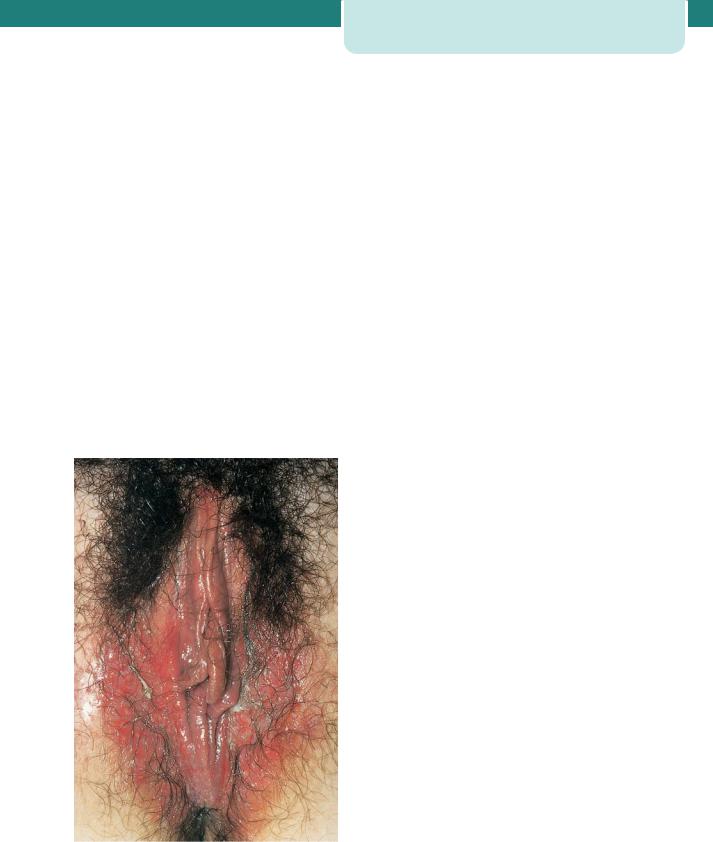
Obstetrics_by_Ten_Teachers_19E_-_Kenny_Louise
.pdf
176Perinatal infections
results in high mortality (approximately 50 per cent). Haemolysis causes jaundice and renal failure.
Fetal effects include premature delivery and low birthweight ( 2500 g). Placental sequestration of parasites is associated with abnormal uteroplacental Doppler waveforms and is also implicated in the higher rate of transmission of HIV. Coinfection with HIV is common in many of the areas where malaria is endemic and both the vertical transmission of malaria and HIV to the fetus seem to be more common if the two infections coexist.
Management
If malaria is suspected, prompt symptomatic and supportive treatment with appropriate antimalarial therapy is important. The choice of antimalarial will vary, depending on local patterns of disease and drug resistance, and expert advice should be sought. In endemic areas preventative strategies include the use of insecticide-treated bed nets and intermittent preventative treatment during pregnancy.
If women from non-endemic areas are planning to travel to endemic areas they should only do this if absolutely necessary during their pregnancy. Insecticide sprays, mosquito nets, appropriate clothing to reduce the risk of mosquito bites and drug prophylaxis can all be used. Expert advice on which antimalarial is appropriate for the area is important. The risks of teratogenicity must be balanced against the serious risk of contracting malaria in pregnancy.
Infections acquired around the time of delivery with serious neonatal consequences
Herpes
Infective organism
Herpes simplex virus (HSV) is a double-stranded DNA virus. There are two viral types, HSV-1 and HSV-2. The majority of orolabial infections are caused by HSV-1. These infections are usually acquired during childhood through direct physical contact such as kissing. Genital herpes is a sexually transmitted infection and is most commonly caused by HSV-2. However, there is an increasing prevalence of genital HSV-1 infections in many countries, including the UK, USA and Scandinavia.
Incidence
Genital herpes is the most common ulcerative sexually transmitted infection in the UK. Neonatal herpes is a viral infection with a high morbidity and mortality which is most commonly acquired at or near the time of delivery due to contact with infected secretions. It is rare, with an incidence of 1 in 60 000 live births.
Clinical features
Genital herpes presents as ulcerative lesions on the vulva, vagina or cervix. The woman may give a history of this being a recurrent problem, in which case the lesion is often less florid. A primary infection may be associated with systemic symptoms and may cause urinary retention.
Neonatal herpes may be caused by HSV-1 or HSV-2, as either viral type can cause genital herpes. Almost all cases of neonatal herpes occur as a result of direct contact with infected maternal secretions, although cases of post-natal transmission have been described.
Neonatal herpes is classified into three subgroups: disease localized to skin, eye and/mouth, local central nervous system disease (encephalitis alone) and disseminated infection with multiple organ involvement (Table 13.1).
Factors influencing transmission include the type of maternal infection (primary or recurrent), the presence of transplacental maternal neutralizing antibodies, the duration of rupture of membranes before delivery, the use of fetal scalp electrodes and the mode of delivery. The risks are greatest when a woman acquires a new infection (primary genital herpes) in the third trimester, particularly within 6 weeks of
Table 13.1 Classification of neonatal herpes
|
Death |
Neurological |
|
(in treated |
morbidity % |
|
babies) % |
|
Localized to |
Rare |
2 |
skin, eye and/ |
|
|
mouth |
|
|
|
|
|
Local CNS |
6 |
70 |
disease |
|
|
|
|
|
Disseminated |
30 |
17 |
infection |
|
|
CNS, central nervous system.

delivery, as viral shedding may persist and the baby is likely to be born before the development of protective maternal antibodies. Very rarely, congenital herpes may occur as a result of transplacental intrauterine infection.
Management
Symptomatic genital herpes infections are confirmed by direct detection of HSV. A swab for viral detection should be used. Any woman with suspected firstepisode genital herpes should be referred to a genitourinary physician, who will confirm the diagnosis by viral culture or PCR, advise on management and arrange a screen for other sexually transmitted infections. The use of aciclovir is associated with a reduction in the duration and severity of symptoms and a decrease in the duration of viral shedding.
It may be difficult to distinguish clinically between recurrent and primary genital HSV infections, as many first episode HSV infections are not true primary infections (Figure 13.2). Advice of a GUM consultant should be sought, as recommendations
Figure 13.2 Primary genital herpes. (Courtesy of Dr Richard Lau, St Georges’s Hospital, London.)
Infections acquired around the time of delivery |
177 |
with serious neonatal consequences |
|
about the mode of delivery depend on whether the woman has a primary or recurrent infection.
Primary infections
Caesarean section should be recommended to all women presenting with primary episode genital herpes lesions at the time of delivery, or within 6 weeks of the expected date of delivery. The rationale for elective Caesarean section in the prevention of neonatal herpes is to reduce exposure of the fetus to HSV in genital secretions.
For women who develop primary genital herpes lesions within 6 weeks of delivery and who opt for a vaginal birth, rupture of membranes should be avoided and invasive procedures such as fetal scalp electrodes, or fetal scalp pH measurement should not be used. Intravenous aciclovir given intrapartum to the mother and subsequently to the neonate may be considered. The neonatologist should be informed and may advise acyclovir treatment of the baby.
Recurrent episodes
A recurrent episode of genital herpes occurring during the antenatal period is not an indication for delivery by Caesarean section.
Women presenting with recurrent genital herpes lesions at the onset of labour should be advised that the risk to the baby of neonatal herpes is very small (1–3 per cent). Although Caesarean section is not routinely recommended for women with recurrent genital herpes lesions at the onset of labour, the mode of delivery should be discussed with the woman and individualized according to the clinical circumstances and the woman’s preferences.
Some women feel that they would not wish to accept the small risk of neonatal herpes infection associated with active recurrent genital herpes at the time of delivery and would opt for Caesarean delivery if HSV lesions were detected at the onset of labour. For these women, daily suppressive aciclovir given from 36 weeks of gestation until delivery may reduce the likelihood of active HSV lesions at term.
Women with recurrent genital herpes lesions and confirmed rupture of membranes at term should be advised to have delivery expedited by the appropriate means. Invasive procedures in labour should be avoided for women with recurrent genital herpes lesions. The neonatologist should be informed of babies born to mothers with recurrent genital herpes lesions at the time of labour.

178 Perinatal infections
Group B streptococcus
Infective organism
Group B streptococcus (GBS) (Streptococcus agalactiae) is a Gram-positive coccus frequently found as a vaginal commensal. It can cause sepsis in the neonate and transmission can occur from the time the membranes are ruptured until delivery.
Prevalence
GBS is recognized as the most frequent cause of severe early-onset (less than 7 days of age) infection in newborn infants. Approximately 25 per cent of women in the UK carry GBS as a commensal in the vagina. The incidence of early-onset GBS disease in the UK is 0.5 per 1000 births.
The mortality from early-onset GBS disease in the UK is 6 per cent in term infants and 18 per cent in preterm infants. Even when treated appropriately, some infants will still die of early-onset disease, particularly when the disease is well established prior to birth.
Screening
Universal screening is carried out in the USA but this practice has not been adopted in the UK. The incidence of early-onset GBS disease in the UK in the absence of systematic screening or widespread intrapartum antibiotic prophylaxis is similar to that seen in the USA after universal screening and intrapartum antibiotic prophylaxis, despite comparable vaginal carriage rates.
The RCOG green-top guidelines review current evidence relating to GBS and conclude that ‘Routine screening (either bacteriological or risk based) for antenatal GBS carriage is not recommended.’
Clinical features
The mother will not have symptoms as GBS is a common vaginal commensal.
An infected neonate may demonstrate signs of neonatal sepsis including sudden collapse, tachypnoea, nasal flaring, poor tone, jaundice, etc.
Management
Antenatal
If GBS is detected incidentally, antenatal treatment is not recommended as it does not reduce the likelihood of GBS colonization at the time of delivery.
Intrapartum antibiotic prophylaxis
It is during labour that infection of the fetus/neonate occurs. Antibiotics given in labour are estimated to be 60–80 per cent effective in reducing early-onset neonatal GBS infection. The difficulty is knowing which women require treatment.
Different approaches are used for screening, to determine which women should receive intrapartum antibiotics.
Risk factor-based prophylaxis
Approximately 15 per cent of all UK pregnancies have one or more of the following risk factors:
•intrapartum fever
•prolonged rupture of membranes (PROM) greater than 18 hours
•prematurity less than 37 weeks
•previous infant with GBS.
Using this strategy, 25 per cent of women will receive intrapartum antibiotics with 50–69 per cent reduction in early-onset GBS infection in the neonate.
To prevent one neonatal death 5882 women need to be treated.
Bacteriological screening using vaginal and rectal swabs
All women would need to have vaginal and rectal swabs at 35–37 weeks gestation. Twenty-seven per cent of women will receive intrapartum antibiotics, with 86 per cent reduction in early-onset GBS infection in the neonate. In the UK, at least 24 000 women would need to be screened and at least 7000 colonized women treated with antibiotics to prevent one neonatal death.
Vaginal and rectal swabs and risk factor screening in combination
Three per cent of women would receive intrapartum antibiotics with a 51 per cent reduction in early-onset GBS infection in the neonate.
The RCOG therefore recommends that intrapartum antibiotic prophylaxis is discussed with women with the following risk factors, and that the argument for using prophylaxis is stronger if more than one risk factor is present; furthermore, if the women has had a previous baby with neonatal GBS

or if GBS bacteruria is detected, as this is associated with a higher risk of neonatal disease.
•Intrapartum fever ( 38º)
•Prolonged rupture of membranes (PROM)18 hours
•Prematurity 37 weeks
•Previous infant with GBS
•Incidental detection of GBS in current pregnancy
•GBS bacteruria.
It is recommended that intravenous penicillin 3 g be given as soon as possible after the onset of labour and 1.5 g 4-hourly until delivery. Clindamycin 900 mg should be given intravenously 8-hourly to those allergic to penicillin.
There is no good evidence to support the administration of intrapartum antibiotic prophylaxis to women in whom GBS carriage was detected in a previous pregnancy.
If chorioamnionitis is suspected, broad-spectrum antibiotic therapy including an agent active against GBS should replace GBS-specific antibiotic prophylaxis.
Women undergoing planned Caesarean delivery in the absence of labour or membrane rupture do not require antibiotic prophylaxis for GBS, regardless of GBS colonization status. The risk of neonatal GBS disease is extremely low in this circumstance.
The neonate
Many infants with early-onset GBS disease have symptoms at or soon after birth. Neonatal sepsis can progress rapidly to death. Whether they received intrapartum antibiotics or not, any newborn infant with clinical signs compatible with infection should be treated promptly with broad-spectrum antibiotics, which provide cover against early-onset GBS disease and other common pathogens. Blood cultures should always be obtained before antibiotic treatment is commenced, and CSF cultures should be considered. Randomized controlled trials have not provided a sufficient evidence base for clear treatment recommendations in well, newborn infants whose mothers had risk factors for GBS. Some clinicians will recommend treatment of the infants, while others will prefer to observe them because the balance of risks and benefits of treatment is uncertain. Each hospital will have its own guideline.
Infections acquired around the time of delivery |
179 |
with serious neonatal consequences |
|
Chlamydia
Infective organism
Chlamydia trachomatis is an obligate intracellular organism.
Prevalence
Chlamydia is the most common sexually transmitted organism in the UK and USA. Between one in 8–10 men and women who are sexually active and under 25 years old screen positive for Chlamydia. In the UK an opportunistic chlamydia screening programme for under 25 year olds has been initiated. Whilst it is not a routine antenatal screening test in the UK, NICE recommends that all women booking for antenatal care, who are younger than 25 years, are informed of the National Screening Programme.
Clinical features
During pregnancy chlamydia is frequently asymptomatic in the pregnant woman. Infection with chlamydia is associated with preterm rupture of membranes, preterm delivery and low birthweight. Transmission to the fetus occurs at the time of delivery and can cause conjunctivitis and pneumonia.
Management
Treatment with azithromicin or erythromycin is recommended. Tetracyclines such as doxycycline should be avoided if possible during pregnancy. Appropriate contact tracing can be arranged via a genitourinary medicine clinic.
Gonorrhoea
Infective organism
Neisseria gonorrhoeae is a Gram-negative diplococcus.
Prevalence
The prevalence of gonorrhoea in pregnancy varies with the population studied. In the UK it is the second most common bacterial sexually transmitted disease.
Clinical features
Gonococcal infection in women is frequently asymptomatic, or women may present with a mucopurulent discharge or dysuria. Rarely, disseminated gonorrhoea may cause low grade fever, a rash and polyarthritis. There is an increased risk

180Perinatal infections
of coinfection with chlamydia, and an increased risk of preterm rupture of membranes and preterm birth. Transmission to the fetus occurs at the time of delivery and can cause opthalmia neonatorum.
Management
Bacteriological swabs should be taken and specific swabs/testing for concomitant infection with chlamydia should also be undertaken. Cephalosporins are effective against gonococcus, but empirical treatment for chlamydia should also be considered. Appropriate contact tracing can be arranged via a genitourinary medicine clinic.
Perinatal infections causing
long-term disease
HIV
Infective organism
The HIV virus is an RNA retrovirus transmitted through sexual contact, blood and blood products, shared needles for i.v. drug users, vertical (mother- to-child) transmission which mainly occurs in the late third trimester, during labour or delivery or breastfeeding.
Prevalence
The prevalence of HIV infection in pregnant women in London in 2001 was about one in 286 (0.35 per cent), a 22 per cent increase from the year 2000 (one in 349 or 0.29 per cent ). Elsewhere in England, the prevalence of HIV infection is reported to be around one in 2256 (0.044 per cent). Most of the pregnant women with HIV in the UK have acquired their infection through heterosexual exposure. Many of the women are of black African ethnicity and were probably infected in sub-Saharan Africa before immigrating to the UK.
Screening
Routine antenatal screening has increased detection rates and new treatments have increased life expectancy.
In the UK, all pregnant women should be offered screening for HIV early in pregnancy because appropriate antenatal interventions can reduce maternal-to-child transmission of HIV infection
from 25 to 30 per cent to less than 2 per cent. Care needs to be taken to ensure that the woman understands the reasons for screening, and that appropriate interventions would be of benefit to her baby. She should also consider the consequences of a positive result prior to embarking on screening, but be reassured about confidentiality and support, should this be the case. A positive HIV antibody test result should be given to the woman in person by an appropriately trained health professional; this may be a specialist nurse, midwife, HIV physician or obstetrician. The issue of disclosure of the HIV diagnosis to her partner should be handled with sensitivity and she should be reassured that her confidentiality will be respected.
Some women remain at risk of becoming infected with HIV during their pregnancy. These women should be offered repeat testing during pregnancy. Rapid HIV tests should be offered to women who present for labour unbooked.
Clinical features
Infection with HIV begins with an asymptomatic stage with gradual compromise of immune function eventually leading to acquired immunodeficiency syndrome (AIDS). The time between HIV infection and development of AIDS ranges from a few months to as long as 17 years in untreated patients.
Management
The principal risks of mother-to-child (vertical) transmission are related to maternal plasma viral load, obstetric factors and infant feeding (Table 13.2).
Interventions to reduce the risk of HIV transmission can reduce the risk of vertical transmission from 25 to 30 per cent to less than 2 per cent:
•anti-retroviral therapy, given antenatally and intrapartum to the mother and to the neonate for
the first 4–6 weeks of life
•delivery by elective Caesarean section
•avoidance of breastfeeding.
The implementation of these three interventions combined is associated with a vertical transmission rate of less than 2 per cent.
All women who are HIV positive should be advised to take antiretroviral therapy during pregnancy and at delivery. The optimal regimen is determined by an

Table 13.2 Risk factors for vertical transmission of HIV
Increased risk of |
Reduced risk of |
transmission |
transmission |
Advanced maternal |
|
HIV disease |
|
|
|
High maternal |
Low or undetectable |
plasma viral load |
viral counts at time |
|
of delivery |
|
|
Low CD4 |
|
lymphocyte counts |
|
|
|
|
Antiretroviral therapy |
|
|
|
Delivery by Caesarean |
|
section |
|
|
Prolonged rupture |
|
of membranes |
|
Chorioamnionitis |
|
|
|
Preterm delivery |
|
|
|
Obstetric |
|
interventions such |
|
as FBS or fetal scalp |
|
electrodes |
|
|
|
Coexisting viral |
|
infections e.g. herpes, |
|
hepatitis C |
|
|
|
Breastfeeding |
Exclusive formula |
doubles |
feeding |
transmission rate |
|
|
|
FBS, fetal blood sampling. |
|
HIV physician on a case-by-case basis. The decision to start, modify or stop antiretroviral therapy should be undertaken by an HIV physician. The choice of treatment and the gestation at which it is commenced will depend on whether the woman needs treatment for her own health or simply to prevent vertical transmission. It also depends on her viral load, viral resistance and whether the woman agrees to delivery by lower segment Caesarean section.
Women who do not require HIV treatment for their own health require antiretroviral therapy to prevent mother-to-child transmission. For these women antiretroviral therapy is usually commenced between 28 and 32 weeks of gestation and should be
Perinatal infections causing long-term disease |
181 |
continued intrapartum. A maternal sample for plasma viral load should be taken at delivery. Antiretroviral therapy is usually discontinued soon after delivery but the precise time of discontinuation should be discussed with the HIV physician.
An elective vaginal delivery is an option for women taking triple drug antiretroviral therapy who have a viral load below 50 copies/mL at the time of delivery. Women who opt for a planned vaginal delivery should have their membranes left intact for as long as possible. Use of fetal scalp electrodes and fetal blood sampling should be avoided. A Caesarean delivery is recommended if a woman is taking azidothymidine monotherapy, or if viral load is above 50 copies/mL at the time of delivery.
A Caesarean delivery should be recommended for women with hepatitis C coinfection as the risk of transmission is higher.
Lactic acidosis is a recognized complication of certain highly active antiretroviral therapy (HAART) regimens and may mimic the symptoms and signs of pre-eclampsia. Presentation with symptoms or signs of pre-eclampsia, cholestasis or other signs of liver dysfunction during pregnancy may indicate drug toxicity and early liaison with HIV physicians should be sought. Where this condition is suspected, liver function tests and blood lactate should be monitored. The presenting symptoms of lactic acidosis are often non-specific but may include gastrointestinal disturbance, fatigue, fever and breathlessness.
Management of infants
The cord should be clamped as early as possible after delivery and the baby should be bathed immediately after the birth.
In the UK, where safe infant feeding alternatives are available, all women who are HIV positive should be advised not to breastfeed their babies as this increases the risk of mother-to-child transmission.
All infants born to women who are HIV positive should be treated with antiretroviral therapy from birth. Zidovudine is usually administered orally to the neonate for 4–6 weeks, unless the mother started antiretroviral therapy late in pregnancy. HAART may be considered for neonates of mothers who started antiretroviral therapy late in pregnancy.
Maternal antibodies crossing the placenta are detectable in most neonates of mother who are HIV positive. This means that neonates test positive

182Perinatal infections
for HIV antibodies. For this reason, direct viral amplification by PCR is used for the diagnosis of infant infections. Typically, tests are carried out at birth, then at 3 weeks, 6 weeks and six months.
Hepatitis B
Infective organism
The hepatitis B virus (HBV) is a DNA virus that is transmitted mainly in blood, but also in other body fluids such as saliva, semen and vaginal fluid. Drug users who share needles are at high risk. In some areas in the world, e.g. China, chronic hepatitis B is prevalent and vertical transmission is very common.
Prevalence
Two billion people worldwide are infected with HBV. More than 350 million have chronic (lifelong) infections.
In the UK, approximately one in 1000 people are thought to have the virus. The prevalence of hepatitis B surface antigen (HBsAg) in pregnant women in the UK has been found to range from 0.5 to 1 per cent. There is wide variation in prevalence among different ethnic groups, and oriental women in particular appear to have a higher prevalence of HBsAg.
recommends that all pregnant women be screened for HBV.
Clinical features
Hepatitis B is a virus that infects the liver, but many people with hepatitis B viral infection have no symptoms. The HBV has an incubation period of 6 weeks to six months.
Management
Women who screen positive for hepatitis B should be referred to a hepatologist for ongoing monitoring for the long-term consequences of chronic infection, for example hepatocellular carcinoma.
To prevent vertical transmission of hepatitis B, a combination of hepatitis B immunoglobulin and hepatitis B vaccine may be given. Virology laboratories will usually advise on the appropriate regime. The combined treatment provides better therapy than either alone. The passive immunoglobulin provides immediate protection against any virus transmitted to the baby from contact with blood during delivery, and should be given immediately after delivery. The active vaccine provides ongoing protection from subsequent exposure in the household. The active vaccine is given in three doses: at birth, at one month and at six months of age.
Screening
Serological screening for HBV should be offered to pregnant women so that effective post-natal intervention can be offered to infected women to decrease the risk of mother-to-child transmission.
As many as 85 per cent of babies born to mothers who are positive for the hepatitis e antigen (eAg) will become HBsAg carriers and subsequently become chronic carriers, compared with 31 per cent of babies who are born to mothers who are eAg negative. It has been estimated that chronic carriers of HBsAg are 22 times more likely to die from hepatocellular carcinoma or cirrhosis than non-carriers.
Mother-to-child transmission of the HBV is approximately 95 per cent preventable through administration of vaccine and immunoglobulin to the baby at birth. To prevent mother-to-child transmission, all pregnant women who are carriers of HBV need to be identified. Because of the high proportion of cases of mother-to-child transmission that can be prevented through vaccination and immunization, the UK National Screening Committee
Hepatitis C
Infective organism
The hepatitis C virus (HCV) is an RNA virus. Acquisition of the virus occurs predominantly through infected blood products and injection of drugs. It can also occur with tattooing and body piercing. Mother- to-child transmission can occur due to contact with infected maternal blood around the time of delivery, and the risk is higher in those coinfected with HIV. Sexual transmission is extremely rare.
Prevalence
In the UK the overall antenatal prevalence has been estimated to be around 1 per cent, with regional variation. The risk of mother-to-child transmission is estimated to lie between 3 and 5 per cent and it is estimated that 70 births each year are infected with HCV as a result of mother-to-child transmission in the UK. The risk of mother-to-child transmission of HCV increases with increasing maternal viral load.

Screening
Current recommendations are that pregnant women should not be offered routine screening for HCV. This is because there is a lack of evidence-based effective interventions for the treatment of HCV in pregnancy, and a lack of evidence about which interventions reduce vertical transmission of HCV from mother to child.
Clinical features
HCV is a major public health concern due to its longterm consequences on health. It is one of the major causes of liver cirrhosis, hepatocellular carcinoma and liver failure. Following initial infection, only 20 per cent of women will have hepatic symptoms, 80 per cent being asymptomatic. The majority of pregnant women with hepatitis C will not have reached the phase of having the chronic disease, and may well be unaware that they are infected.
Management
Testing for HCV in the UK involves detection of anti-HCV antibodies in serum with subsequent confirmatory testing by PCR for the virus, if a positive result is obtained. Upon confirmation of a positive test, a woman should be offered post-test counselling and referral to a hepatologist for management and treatment of her infection.
In non-pregnant adults, interferon and ribavirin can be used to treat hepatitis C infection, but these are contraindicated in pregnancy.
There is no strong evidence regarding mode of delivery in women with hepatitis C. Consensus groups therefore do not recommend elective Caesarean section for all women with hepatitis C, although it is recommended if the woman is also HIV positive.
C A S E H I S T O R Y
Perinatal infections causing long-term disease |
183 |
Key points
•Infectious diseases contracted during pregnancy can have a serious impact on both the mother and the fetus.
•Infections can cause congenital abnormalities in the fetus (rubella, syphilis, toxoplasmosis, cytomegalovirus, chickenpox). Some infections can be transmitted from mother to baby during pregnancy and affect the fetus in utero (parvovirus, syphilis).
•Some infections can be transmitted to the fetus around the time of delivery, and appropriate obstetric management can reduce the risk of transmission (HIV, hepatitis B, hepatitis C, herpes, group B streptococcus).
•For some infections screening programmes and effective interventions can improve the outcome for the mother and baby.
New developments
•In recent years a non-invasive method has been developed to diagnose and monitor fetal anaemia. This is done by using Doppler ultrasound to measure the velocity of blood flow in the fetal middle cerebral artery. Faster flow is indicative of fetal anaemia. This has improved
the diagnosis and management of fetuses infected with parvovirus, as the main effect of this infection is anaemia.
•Antiretroviral HIV therapies have been developed and research has focused on which therapies are more appropriate for different groups of women.
•Hepatitis B vaccination programmes are being extended worldwide. In some countries such as Taiwan, this
has already resulted in lower transmission rates and a reduction in childhood hepatocellular carcinoma.
•Further research is needed into the treatment of hepatitis C in pregnancy with antiviral agents, and into the most appropriate mode of delivery in women with hepatitis C. The development of a hepatitis C vaccination would confer long-term health benefits.
Ms B is a 30-year-old shop assistant. This is her first pregnancy and she attends for a routine anomaly scan at 20 weeks gestation. She has no family history or past medical history of note and has been well throughout her pregnancy.
On the ultrasound scan the fetus is seen to be small, approximately 18 weeks size. The ventricles in the
brain measure 12 mm (the upper limit of normal is 10 mm).
There is a small amount of fetal ascites and some fetal skin oedema.
What are the possible causes?
These ultrasound findings could be due to congenital infection, chromosomal abnormality in the fetus or genetic disorders. Various infections could cause these ultrasound abnormalities including syphilis, rubella, CMV and toxoplasmosis.
continued 

184 Perinatal infections
C A S E H I S T O R Y continued
What would you do next? |
Results |
The first steps would be to take a careful history for symptoms suggestive of a viral illness or contact with illness.
The results of her routine screening blood tests taken at the booking visit should be checked. (These showed that she was immune to rubella and tested negative for syphilis.)
The virology lab should be asked whether they had retained the original sample and this should be checked for toxoplasmosis and cytomegalovirus antibodies. (She did not have any antibodies to these on her initial sample.) A further sample should be taken to be tested for toxoplasmosis and cytomegalovirus antibodies to see whether antibodies had developed. This would suggest recent infection.
She should be offered an amniocentesis to exclude chromosomal abnormalities. The amniotic fluid should also be tested for toxoplasma and CMV.
The initial booking blood sample did not have any antibodies for CMV. The sample sent on the day of her anomaly scan had CMV IgM, suggesting a recent infection. The PCR on the amniotic fluid showed that it contained CMV.
These results together with the ultrasound findings confirm a diagnosis of congenital CMV infection.
What would you do next?
The results should be explained to Ms B. The likelihood of a very poor prognosis for the baby should be explained and termination of pregnancy offered. Throughout this she would need support and
compassion. It should also be explained to her that since she would now be immune to CMV this would not happen again in a future pregnancy.

C H A P T E R 1 4
L A B O U R
Alec McEwan
.................................................................................................Introduction |
185 |
................................................................................Pain relief in labour |
203 |
Fetal and maternal anatomy relevant to labour .................. |
186 |
Abnormal labour....................................................................................... |
208 |
The process of labour........................................................................... |
191 |
Labour in special circumstances .................................................. |
217 |
Understanding the physiology of labour................................... |
194 |
Induction of labour.................................................................................. |
219 |
Place of birth .............................................................................................. |
195 |
Clinical risk management .................................................................. |
223 |
Management of normal labour....................................................... |
196 |
|
|
|
|
|
|
O V E R V I E W
Labour can be defined as the process by which regular painful contractions bring about effacement and dilatation of the cervix and descent of the presenting part, ultimately leading to expulsion of the fetus and the placenta from the mother. This gross oversimplification hides a multitude of medical, social, cultural and ethical variables which combine together in a complex interplay and mean that labour and delivery can often have a long-lasting physical and emotional impact, which may be positive or negative. A doctor or midwife who manages labour must be aware of the normal anatomy and physiology of the mother and fetus, what distinguishes an abnormal from a normal labour, and when it is appropriate to intervene.
Introduction
Approximately 600 000 women give birth in the United Kingdom each year. Labour and delivery are both a physical and emotional challenge for the mother and represent a potentially hazardous journey for the fetus. There is a complex interaction between the ‘powers’ of the uterus (the contractions), the ‘passages’ of the birth canal (the bony pelvis and the soft tissues of the pelvic floor and perineum) and the ‘passenger’ (the fetus) which means that no two labours are ever quite the same. Contractions are necessary to promote dilatation of the uterine cervix and descent of the fetus, however during each one, the placenta is temporarily deprived of blood flow, and consequently the fetus of its oxygen supply.
Labour brings great joy and happiness to the majority of families, but maternal and fetal outcomes are not always good, and are frequently suboptimal. Maternal death is rare in the Western world, but remains frequent in many countries that have less developed healthcare systems. Complications of labour account for a significant proportion of maternal deaths in these countries, where childbirth is often unattended. This must not be confused with ‘natural childbirth’, a term used to describe a form
of care in labour that utilizes minimal technology and natural methods of pain relief. Women have widely different expectations of labour and delivery, influenced by previous experiences, friends and family, social, religious and cultural factors, the media and healthcare professionals. In the Western world, the expectation is usually that the outcome will be ‘normal’ and this is one reason why rates of litigation are so high following supposed intrapartum mismanagement. Maternal choice remains a high priority for policymakers, and also most midwives and obstetricians. Where a woman should give birth, who should care for her in labour, how she might deliver and with what kind of pain relief, are all key issues that are decided by a multitude of factors, including maternal choice. Natural childbirth may be sought by women who perceive that birth in the Western world has been ‘hijacked’ by modern medicine and modern doctors. Conversely, there is now a small but significant minority of women who have the opposite philosophy: they have opted to avoid labour altogether and to elect for planned Caesarean section. Although this remains a contentious issue, many women have an increasing expectation that mode of delivery should be a matter of choice. The average Caesarean section rate in the UK is approximately 21 per cent,
